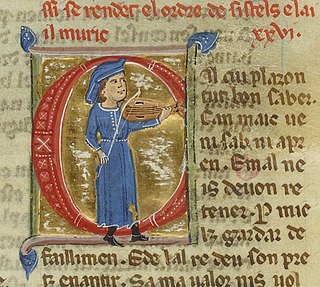
A troubadour was a composer and performer of Old Occitan lyric poetry during the High Middle Ages (1100–1350). Since the word troubadour is etymologically masculine, a female equivalent is usually called a trobairitz.

Guiraut Riquier de Narbona is among the last of the Occitan troubadours. He is well known because of his great care in writing out his works and keeping them together—The New Grove Dictionary of Music and Musicians considers him an "anthologist" of his own works.

Peire Cardenal was a troubadour known for his satirical sirventes and his dislike of the clergy. Ninety-six pieces of his remain, a number rarely matched by other poets of the age.

Rigaut de Berbezilh was a troubadour of the petty nobility of Saintonge. He was a great influence on the Sicilian School and is quoted in the Roman de la Rose. About fifteen of his poems survive, including one planh and nine or ten cansos. His name is sometimes given as Richart or Richartz.
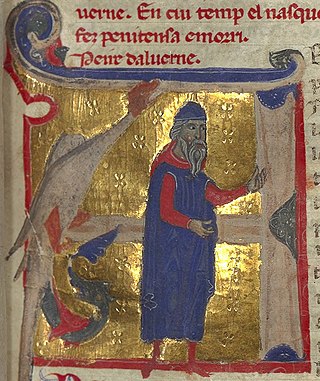
Peire d'Alvernhe or d'Alvernha was an Auvergnat troubadour with twenty-one or twenty-four surviving works. He composed in an "esoteric" and "formally complex" style known as the trobar clus. He stands out as the earliest troubadour mentioned by name in Dante's Divine Comedy and De vulgari eloquentia.
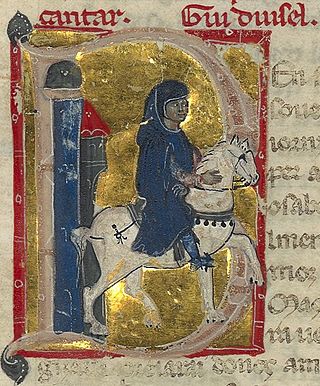
Gui d'Ussel, d'Ussèl, or d'Uisel was a troubadour from the Limousin. Twenty of his poems survive: eight cansos, two pastorelas, two coblas, and eight tensos, several with his relatives and including a partimen with Maria de Ventadorn. Four of his cansos melodies remain.

Daude, Deude, Daurde, or Daudé de Pradas was a troubadour from Prades-Salars in the Rouergue not far from Rodez. He lived to an old age and left behind seventeen to nineteen cansos, including twelve on courtly love, three about sexual conquest, one tenso, one planh, and a religious song. Only one melody of his entire oeuvre has survived.
Henry II, of the House of Millau, was the Count of Rodez and Viscount of Carlat from 1274 until his death. He was the son of Hugh IV of Rodez and Isabeau de Roquefeuil.
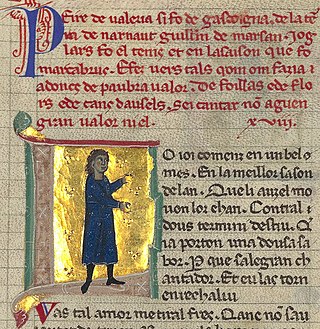
Peire de Valeira, Valeria, or Valera was a Gascon troubadour. Since troubadour poetry probably originated in northwest Aquitaine and first spread—within a generation—south into Gascony, Peire was one of the earliest troubadours. Only two of his poems survive, one canso and one cobla.

Giraut or Guiraut de Calanso or Calanson was a Gascon troubadour in the Occitan language. Of his lyric works that remain five are cansos, two descorts, a congé, a planh, and a vers. He also wrote a mock ensenhamen entitled Fadet juglar.

Albertet de Sestaro, sometimes called Albertet de Terascon, was a Provençal jongleur and troubadour from the Gapençais. Of his total oeuvre, twenty three poems survive. "Albertet" or "Albertetz" is the Occitan diminutive of Albert. Unqualified, it usually refers to Albertet de Sestaro, but there was an Albertet Cailla.

Uc de la Bacalaria was a Limousin troubadour from La Bachellerie near Uzerche, the home town of Gaucelm Faidit. According to his vida, he was a jongleur who travelled infrequently and was hardly known. He composed cansos, tensos, one alba, and one descort. Six songs are surviving: one canso, one alba, and four tensos. According to the vida, he was courtly, capable, and learned.
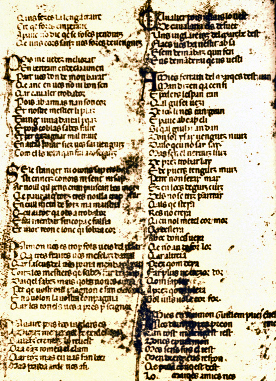
Ferrari da Ferrara, fully Ferrarino (dei) Trogni da Ferrara, was a troubadour of Ferrara in the late 13th and early 14th centuries. He was a composer, anthologist, and possibly autobiographer. He was one of the last active troubadours in Italy.

Gui de Cavalhon, Cavaillo, or Gavaillo was a Provençal nobleman: a diplomat, warrior, and man of letters. He was probably also the Guionet who composed tensos and partimens with Cadenet, Raimbaut de Vaqueiras, Mainart Ros, Pomairol, and a certain Guillem.

Raimon de (las) Salas or la Sala was a Provençal troubadour probably of the 1220s/1230s. His short vida survives. He left behind four or five poems, but he must have composed more, since he is vida records his composition of cansos, albas, and retroensas. Along with Ferrari da Ferrara, he is the only troubadour known to have tried his hand at the retroensa.
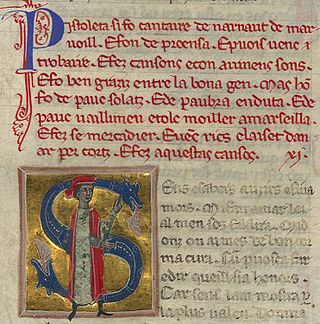
Pistoleta was a Provençal troubadour. His name means "little letter (epistle)" in Occitan. He left behind eleven songs, comprising nine cansos and two tensos. Some of his pieces are assigned to an otherwise unknown Jordan de Born in the table of contents of chansonnier C, a fourteenth-century Occitan manuscript.

Rainaut de Pons, in French Renaud de Pons, was a troubadour from the region of Saintonge in the County of Poitou. According to his vida, he was lord of the castle of Pons. He composed tensos with Jaufre de Pons, one of his retainers according to the vida. One of their partimens survives in several manuscripts.

A torneyamen or certamen was a lyric genre of the troubadours of the thirteenth century. Closely related to the tenso, a debate between two poets, and the partimen, a question posed by one poet and another's response, the torneyamen took place between several poets, originally usually three. The first three-way tenso was initiated by Raimbaut de Vaqueiras with Ademar de Peiteus and Perdigon. These wider tensos only became known as torneyamens later. A tenso or partimen that was submitted to another troubadour for adjudication may have a poetic jutjamen (judgement) attached to it and so may be considered as a torneyamen between three. The torneyamen, like the related debate forms, was probably especially common at contests, such as floral games and puys. Many such tensos and partimens come with attached jutjamens rendered in verse, as in the example Senyer Bernatz, dues puncelhas say cited below.
Bonfilh or Bonfils was a Jewish troubadour from Narbonne. He is the only known Jew who wrote in the troubadour style and language, Old Occitan. His only known work is a partimen (debate) with Guiraut Riquier, Auzit ay dir, Bofil, que saps trobar. It has been suggested that Bonhilh may have been a poetic invention of Guiraut and not a historical person, or that he was the same person as the Jewish poet Abraham Bedersi. There is a lacuna in the only surviving manuscript version of this song that lasts from the middle of the third stanza through to the middle of the fifth. The seventh stanza is also missing the ending of its final line. Each stanza has eight lines, but the last two are tornadas of four each.